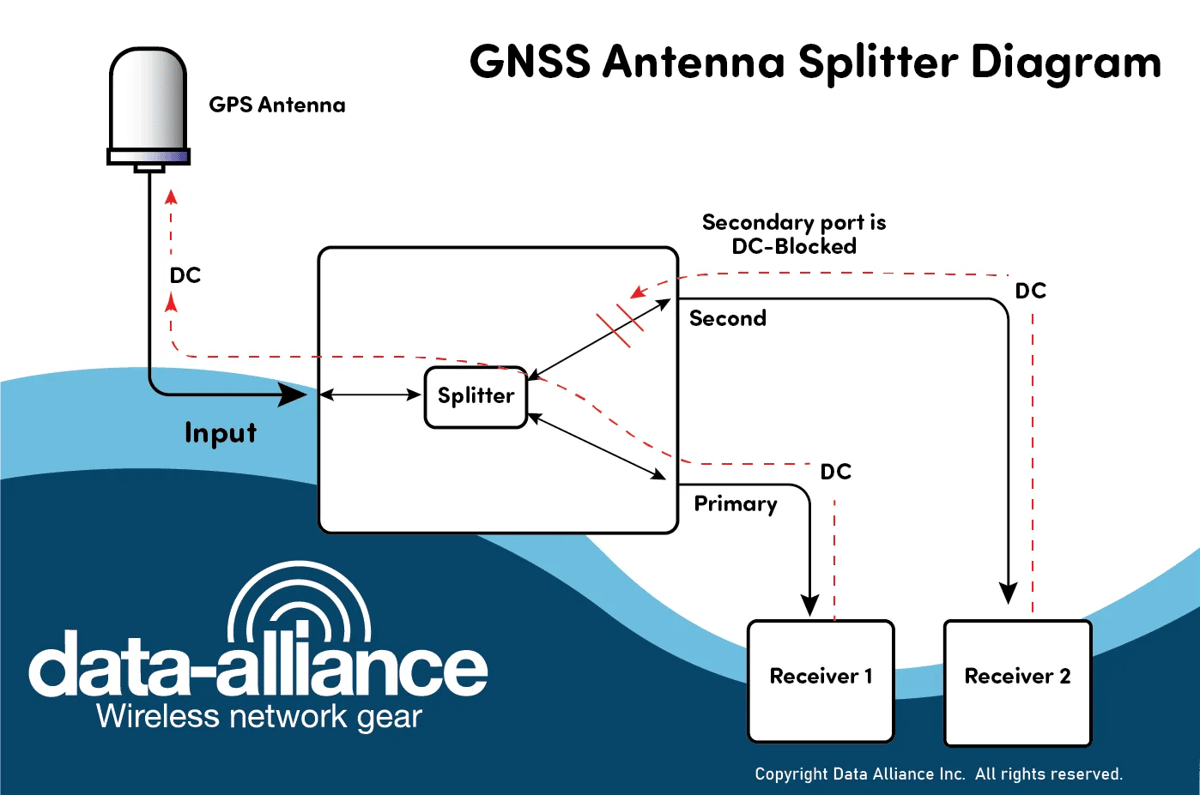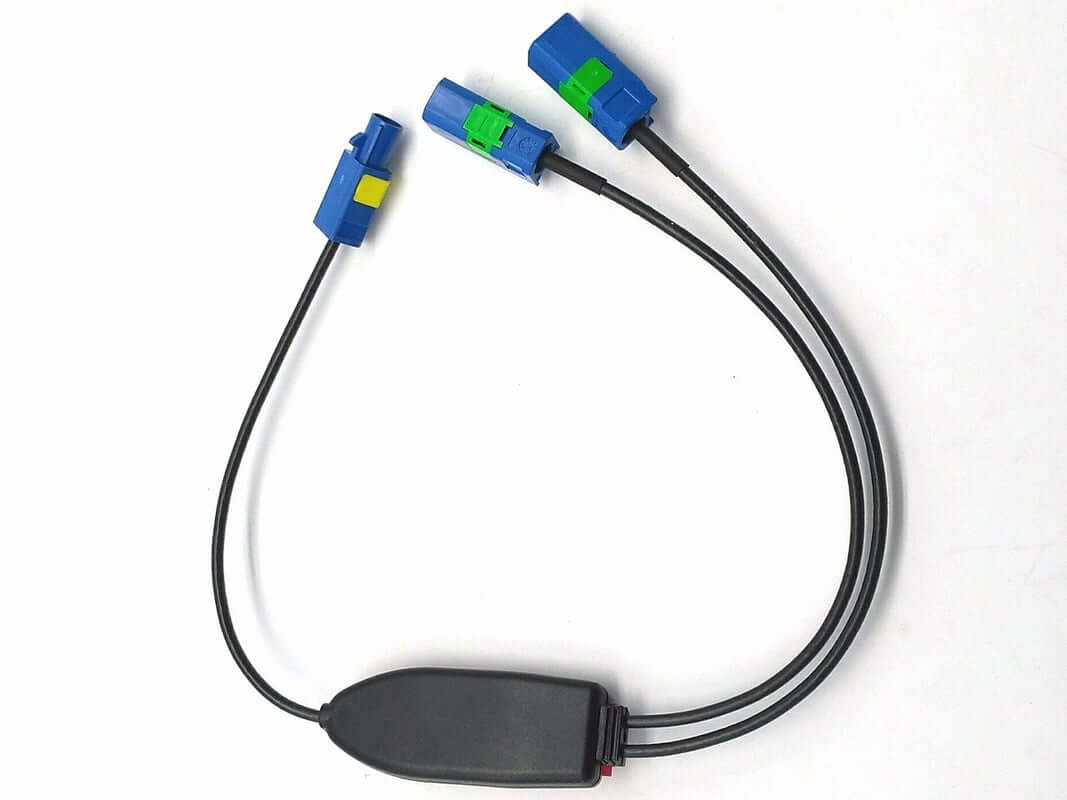Antennas, Antenna Cables, Wireless Products: Technical Articles
GNSS Signal Splitters for GPS Antennas
GNSS Signal Splitters for GPS Antennas
A GNSS splitter is a radio device that splits an input feed from a single GNSS antenna between multiple connected GNSS receivers or repeaters. The splitter passes input signals that are within the GNSS range, with the signal transmitted simultaneously to each connected receiver.
In-line splitters are an essential solution for providing dependable synchronized GNSS signaling for multiple synchronization devices and position and timing applications.
There are several formats of GNSS splitter but the most common splitters are either:
- 1x2 splitter: one single antenna input that is split into two GNSS signal outputs
- 1x4 splitter: one single antenna input that is split into four GNSS signal outputs
- 1x8 splitter: one single antenna input that is split into eight GNSS signal outputs
- 1x64 splitter: one single antenna input that is split into 64 GNSS signal outputs

A GNSS spitter is advantageous because the multiple ports it provides save on the cost, time, and cable runs required to install multiple individual antennas and surge suppressors for attached devices. Multiple receivers can be competently served by a single GNSS splitter. GNSS splitters support the most common types of radio navigation including GNSS, GLONASS, and Galileo. Depending on the GNSS technology the splitter handles, these devices support the following frequencies:
- L1
- L2
- L5
The GNSS splitter is highly isolated to minimize the risk of unwanted interference or interaction between different GNSS receivers. Port-to-port isolation mitigates oscillation problems like local oscillator leakage and reduced yields.
Insertion losses are another factor that has to be considered when using a GNSS splitter. Basic 1x2 GNSS splitters that send half of the input signal to each output port have signal losses of approximately -3 dB, while a 1x3 splitter has an insertion loss of -5 dB and a 1x4 splitter has an insertion loss of -7 dB. This means that the splitter with the fewest ports should be selected, to keep insertion losses to a minimum. Good build quality is essential for this component as GNSS splitters and the attached antenna are vulnerable to becoming a point of failure for all connected receivers. GNSS splitters that are four ways or higher will affect a larger number of receiving devices if there is a failure or downtime.
Most designs are built to withstand indoor and outdoor conditions with suitable ingress protection ratings. The cost of a quality splitter may be greater than the cost of basic GNSS antennas and cables for each receiver.
Key types of GNSS splitter
There are two main types of GNSS splitters, passive and active splitters:
Passive GNSS splitters
Passive GNSS spitters, also known as DC-pass splitters receive their power from connected GNSS receivers so they do not require their own power supply unit. The DC power from the connected receiver is adequate for powering the splitter and antenna.
Passive spitters (and the connected antennas) can receive their DC voltage from:
- Both recipient receivers via a primary and a secondary port
One receiver via a primary port, called DC through, while the secondary port is DC blocked. - DC power supplied through the coaxial cable
- The power usually comes from one of the multiple attached receivers and some splitters can draw power from alternate receivers if the powering receiver is disconnected or the voltage it supplies is too low.
Active GNSS splitter
These self-powering splitters are also known as DC-blocked splitters. They carry a PSU that powers both the splitter and GNSS antenna. Because active GNSS splitters are powered, the voltage of the splitter must be matched to the antenna. GNSS antennas have a voltage range between 2.5 and 12 VDC so most active splitters supply power within this range for reliable performance.
Amplified GNSS splitters
An amplified GNSS splitter has built-in signal amplification. The amplification compensates for insertion losses up to 24 dB and saves on adding a separate in-line amplifier. GNSS amplifiers are also powered by the splitter to a voltage range of 5 to 20VDC.
Rackmount GNSS splitters
Rackmount splitters are used for precision GNSS connectivity in indoor research and laboratory environments. These splitters with a row of panel-mounted radio connectors can split a single GNSS antenna input up to 32 ways. Rackmount splitters are active splitters with an adequate power supply to amplify the signal and compensate for insertion losses.
Sample GNSS splitter physical specifications
Here are examples physical specifications of a typical 1x2 GNSS splitter:
- One GNSS input, two GNSS outputs
- RF connectors:
- Weight: 0.55 pounds (250 grams)
- Active GNSS spitters have a DC power unit source voltage
- Other typical components include:
- Aluminum housing with mounting holes
- Electromagnetic interference shielding
- Surge protection
- Sealant and waterproofing
GNSS spitter sample electrical specs
- Frequency range: 1 to 2 GHz
- Input and output impedance: 50 Ohm
- Insertion loss: <3-4 dB
- Isolation: >18dB
- Amplified gain: 24 dB
- Gain flatness: <2 dB
- Noise figure: 1.8 dB
- DC throughput: 3 - 12 V
GNSS splitter applications
GNSS splitters are high-utility device that has several important applications:
Splitters for high-precision GNSS
 Splitters are used in precision GNSS navigation and testing applications that require highly accurate GNSS time, and location data. They are especially useful in devices or vehicles that can only accommodate a single GNSS antenna. Precision GNSS applications that use splitters include:
Splitters are used in precision GNSS navigation and testing applications that require highly accurate GNSS time, and location data. They are especially useful in devices or vehicles that can only accommodate a single GNSS antenna. Precision GNSS applications that use splitters include:
- Surveying
- Reference stations
- Telecoms
GNSS splitters are routinely used with NTP servers Network Time Protocol (NTP) servers are responsible for synchronizing the clocks of networked computers and other devices. The NTP server receives a GNSS signal via a splitter to use the satellite broadcast signal as a primary time source.
These open-circuit devices have over current antenna detection. An attached GNSS splitter must emulate an antenna for the NTP to function. This is done by fitting a resistor across the outputs of a GNSS splitter.
GNSS splitters for unmanned aerial vehicles and robotics
Spitters help devices like drones, unmanned vessels, and robots navigate precisely. A splitter allows the number and cost of GNSS antennas in these Cost, Size, Weight, and Power (cSWaP) constrained devices to be kept low.
GNSS splitter FAQs
What does a GNSS splitter do?
A GNSS splitter receives a GNSS signal input from a single antenna and divides it across multiple output receivers.
Can you split a GNSS signal?
Yes, a GNSS splitter can competently split a single input GNSS signal into multiple output signals. The signal is unchanged and only affected by insertion losses.
What is the difference between GNSS active and passive splitter?
Active GNSS splitters have their own DC power input, while passive GNSS splitters receive their DC power from the connected GNSS receivers.
Do passive splitters require power?
Passive splitters require power but it is drawn from the connected GNSS receivers.







